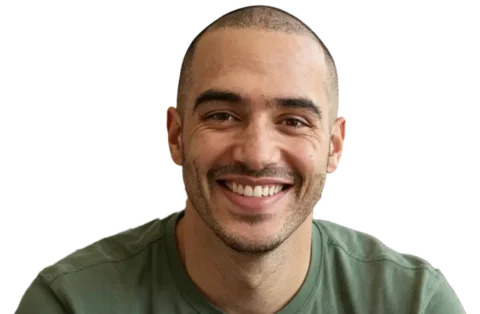What you’ll learn
You’ll come away with a clear understanding of what buprenorphine is, its role in the composition of Suboxone®, and why many people find it so effective in the treatment of opioid use disorders (OUDs) when paired with therapy. You’ll also get a sense of what treatment looks like, what to expect at each stage, and how QuickMD can help you on your path to recovery.
If you’ve been battling opioid use disorder (OUD) and thinking about getting help, buprenorphine may have come up in conversation. Buprenorphine is a medication that helps reduce cravings and ease withdrawal symptoms while you begin your recovery process. It’s a key ingredient in Suboxone,® one of the most widely recommended treatments for OUD.
Buprenorphine is a partial opioid agonist. That means it works on the same brain receptors that stronger opioids do, but more gently. It has a “ceiling effect,” which limits how strong its euphoric and respiratory effects can get. Naturally, if you’re thinking about treatment, you want to know as much as possible about your options and how they work. Buprenorphine can be a game-changing medication that helps ease you into a new phase of life and smooth the path to a brighter future.
The road to recovery doesn’t have to be a solitary path. Here at QuickMD, we want to empower you with real support and zero judgment to help you more easily navigate this process. We know it’s normal to be curious about different treatment methods. In this article, we’ll walk you through how buprenorphine is used to treat OUD, how it works, its benefits and side effects, and what the treatment process usually looks like.
What is buprenorphine used for?
Buprenorphine is a medication prescribed to help treat opioid use disorder. Because it binds to the brain’s opioid receptors, it soothes cravings and eases withdrawal symptoms without causing the same high or risk that full opioids bring.
What sets it apart is its ceiling effect. This means that even if someone takes more than the prescribed amount of buprenorphine, the effects don’t continue to increase in a dangerous way. That makes the risk of overdose lower compared to full opioid medications. And because it doesn’t give the same strong “rush” your brain might have been chasing, it decreases the likelihood of misuse.
Make no mistake about it: opioid use is not a moral failing. It’s a chronic brain disorder that requires compassionate care. It’s also treatable, and there are many treatment methods available. Buprenorphine is a key ingredient in many pharmaceuticals used to treat OUD, including Suboxone®, Subutex®, and Sublocade®, among others. Suboxone (which combines buprenorphine with naloxone, an opioid antagonist that counters the effects of opioids) is often chosen because it helps with safety and misuse prevention.
Learn more about buprenorphine and how it can help your recovery.
How buprenorphine works
Understanding how buprenorphine works can help you feel more in control as you start your recovery journey.
As a partial agonist, buprenorphine attaches to opioid receptors but only activates them partially. This provides relief and lessens the pain and symptoms of withdrawal, but also reduces the severity of the harmful effects of a full opioid.
Because it binds strongly to those receptors, if someone tries to use a stronger opioid while on buprenorphine, the medication blocks its effects. This built-in safeguard helps protect against relapse. Buprenorphine’s “ceiling effect” means there’s a limit to how much respiratory depression or euphoria it can cause. That’s part of why it’s a preferred alternative to other medications (like methadone) because it reduces the risk of overdose.
Benefits of buprenorphine in recovery
As part of a comprehensive Medication-Assisted Treatment (MAT) program that includes counseling and ongoing support, buprenorphine can help people on their recovery journey. Its benefits include:
- Reducing withdrawal symptoms: Buprenorphine helps soften the worst parts of opioid withdrawal (including sweating, nausea, restlessness, and chills), making it easier to help you focus on your recovery.
- Ceiling effect: Because it has a limit on how strongly it can activate the opioid receptors, there is a safety buffer. That means taking more doesn’t give a stronger high, which lowers some risks associated with high-dose misuse.
- Blocking other opioids: Buprenorphine can prevent or lessen the effects of other opioids in your system. If someone tries to use other opioids, buprenorphine often won’t allow them to feel the same “high,” which helps reduce the potential to relapse.
- Diminishing opioid cravings: When your body is used to stronger opioids, cravings can feel overwhelming. Buprenorphine helps by gently satisfying the brain’s opioid receptors, giving you greater control over urges.
Pairing buprenorphine with therapy (including one-on-one counseling, mental health support, or peer groups) can help offer stronger results and reduce the risk of relapse.
Possible side effects of buprenorphine
Most people respond really well to buprenorphine. As with any medication, there are some side effects you may experience with buprenorphine. This is a normal part of the recovery process, and the benefits of taking your medication as prescribed far outweigh any temporary discomfort. In many cases, these symptoms improve in days or weeks.
These side effects include:
- Nausea
- Sleep problems
- Constipation
- Dizziness
- Fatigue
- Stomach pain
- Skin rashes
- Sweating
If you’re still dealing with tough symptoms after a while or feel like you’re experiencing something unusual, reach out to your provider immediately.
Disclaimer: This section is for educational purposes only. It is not meant to be a substitute for medical advice. If your symptoms get worse or you feel unsafe at any time, go to the nearest emergency room.
Buprenorphine treatment process
We understand that recovery isn’t a straight line. But you have to start somewhere, and you don’t have to do it alone. A MAT program that incorporates buprenorphine can make it easier to take those initial steps toward recovery. At QuickMD, you’ll have reliable providers and counselors to lean on at every stage. You never have to guess what to expect during your treatment program, and your provider is there to help you feel safe and heard.
Our MAT program can help you get flexible, consistent care that meets you where you’re at. If today is the day you decide to take the next step toward reclaiming your health, we offer same-day virtual visits so you can meet a licensed provider and begin putting together a plan that works for you.
As part of a comprehensive MAT program, buprenorphine therapy starts with an initial consultation and then takes you through three different phases:
- Induction
- Stabilization
- Maintenance
You and your provider will work together to create a treatment program that works for you. Whether that involves taking buprenorphine for months or even years, it’s important to know that there is no standard cut-off period because everyone has unique needs.
Let’s walk through each of those stages in greater detail to help you better understand the road ahead.
Step 1. Induction
During this important first phase, the goal is to help you get through the withdrawal stage without significant symptoms. In the induction period, you’ll meet with a licensed QuickMD provider who will prescribe your first dose of buprenorphine. You can safely start taking your first dose after any opioids have been out of your system for a specific period of time. Your provider will discuss with you the safest approach to start treatment. It is usually around the time when withdrawal symptoms are present and feel moderate, but haven’t become overwhelming.
You’ll receive a seven-day supply of buprenorphine and book a follow-up visit within a week. After the first seven days, you and your provider will discuss your experience. They’ll make any necessary adjustments to help you continue feeling better. You will then continue treatment and book a virtual visit the following month to check in with your provider and receive your next prescription.
Step 2. Stabilization
After induction, your provider will check in with you during regularly scheduled visits. They’ll monitor your progress, adjust doses, address side effects, and make sure your cravings and withdrawal symptoms are under control. This stage usually lasts several weeks.
Stabilization is all about ensuring that you’re in good shape to focus on your recovery. We can make any necessary adjustments to your medication so that it truly works for you. During this stage, the goal is for you to start feeling more comfortable with where you are in the process.
Step 3. Maintenance
During the maintenance phase, your provider will continue to support you on your path to recovery. Many people stay in this phase for as long as needed. You’ll continue to have regular check-ins with your provider. Keeping an honest, open dialogue with your provider can help them determine if any adjustments need to be made to your therapy.
As you continue your treatment program, you’ll likely continue receiving buprenorphine while you’re working on rebuilding your life and healthy relationships. There is no universal timeline. What matters most is what works for you. Our team is here to help ensure you receive the support you need at every step.
H2: How QuickMD supports OUD with buprenorphine
We get it. Asking for help takes courage. At QuickMD, we’re here to listen without judgment and help you take those first steps towards recovery and stick with you through the long haul.
- We offer same-day online visits so you don’t have to wait days to get help or worry about how to get to your appointment.
- If you don’t have insurance or have gaps in coverage, we offer a flexible cash pay option. Cost shouldn’t be what stops you from getting help.
- Recovery is about more than just medication. Our Medication-Assisted Therapy (MAT) program combines a prescription from a licensed provider alongside ongoing support in the form of regular virtual check-ins and therapy.
There is always hope. With the right support, many people have been able to look to buprenorphine as a reliable tool in conquering dependency. You’re not alone. At QuickMD, we’re here to help.
Frequently asked questions about buprenorphine
How long does buprenorphine treatment last?
Everyone’s path is different. Some people use buprenorphine for months. Others stay on it longer. Let’s shake off that stigma right now. It’s not trading one addiction for another. Buprenorphine helps people in recovery receive treatment for OUD. Your provider will help you decide what’s best for your health, depending on how long you’ve used opioids, how stable your situation is, and your recovery goals.
How is it different from methadone?
Buprenorphine has a lower risk of overdose and respiratory depression (slow or shallow breathing) than methadone, thanks to its ceiling effect. While methadone can be helpful in some cases, many providers prefer prescribing buprenorphine because of how it balances effectiveness with safety.
Can I get buprenorphine online?
Yes. You can get buprenorphine online, but only with a prescription. Telemedicine laws and DEA updates have made it possible for many people to start or continue treatment with a provider online. This makes treatment safer and more accessible, especially if your schedule, transportation, or privacy is a concern.
How long do people usually take buprenorphine?
There’s no set timeline. Some folks taper off after feeling stable for a while. Others stay on maintenance for years. The right length depends on your recovery goals, health status, and how you feel over time.




